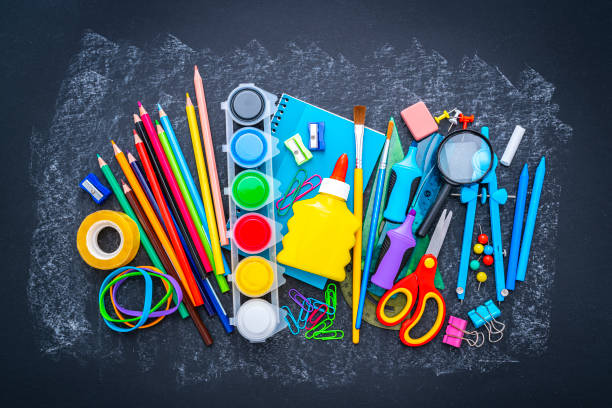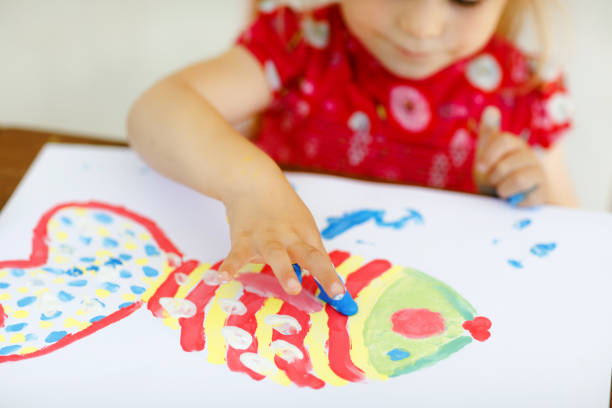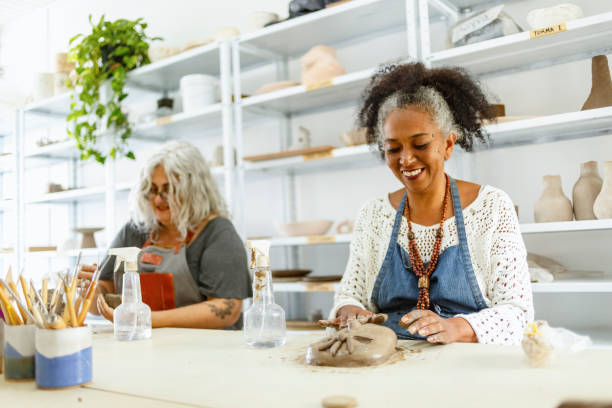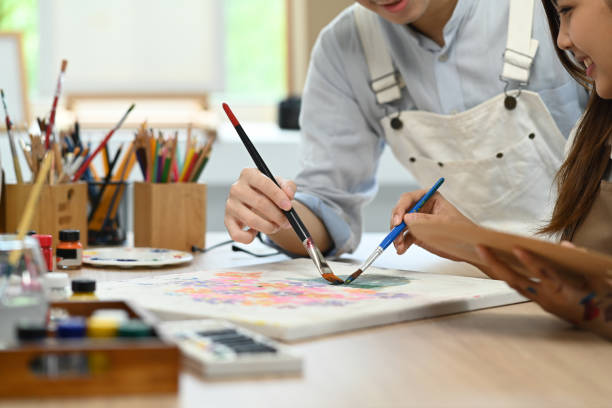Zero-waste art and crafts is more than just a trend; it’s a crucial practice that aligns creativity with environmental responsibility. Artists and crafters have the unique opportunity to reduce their ecological footprint by choosing materials and methods that are kinder to the planet. Zero-waste art and craft are vital because a sustainable approach reduces emissions by 84%.
Sustainable art emphasizes the use of non-toxic, eco-friendly materials, and furthermore, promotes the idea of creating beauty without compromising the health of our environment. Additionally, by embracing sustainable practices, artists can inspire others to think more critically about their consumption habits and, consequently, the impact they have on the world.
How Zero-Waste Art Benefits the Environment
Zero waste art significantly reduces the amount of waste that ends up in landfills. By reusing and repurposing materials, artists can minimize the demand for new resources, thus conserving energy and reducing pollution.
Sustainable crafts also encourage a circular economy where products and materials are continuously reused, recycled, or composted. This approach helps in cutting down on greenhouse gas emissions and decreases the overall environmental footprint. Additionally, zero-waste art often educates and raises awareness about environmental issues because it fosters a culture of sustainability and mindfulness.
Commonly Used Recycled Materials in Crafting

Recycled materials are the cornerstone of zero-waste art and sustainable crafts. Some of the most commonly used materials include:
- Paper and Cardboard: You can transform old newspapers, magazines, or cardboard boxes into beautiful artworks. It is also possible to create everything from papier-mâché sculptures to handmade paper using these materials.
- Plastic: Items like plastic bottles, caps, or containers can be repurposed into planters, mosaics, and even jewelry.
- Glass: Clean and use glass jars and bottles as vases, candle holders, or storage containers. Decorate with paints or other materials.
- Fabric and Textiles: Scraps of fabric, old clothing, and even discarded upholstery can be turned into quilts, bags, or patchwork projects.
- Metal: Tin cans, bottle caps, and other metal items can be creatively used in various projects, such as garden art or decorative items.
- Wood: Old furniture, pallets, and other wood sources can be repurposed into new furniture, picture frames, and other home decor items.
Getting Started: Essential Tools and Materials
To embark on your zero-waste crafting journey, having the right tools is essential. Zero-waste schools have taught us that some must-haves include:
- Scissors and Craft Knives: Sharp tools for cutting various materials like paper, fabric, and plastic.
- Glue and Adhesives: Eco-friendly glues, such as non-toxic white glue or hot glue, to be used on a variety of surfaces.
- Cutting Mats and Rulers: Protect your work surface and ensure precise cuts with durable cutting mats and metal rulers.
- Paints and Brushes: Non-toxic, water-based paints and a variety of brush sizes for different effects.
- Sewing Kit: Needles, thread, and a sewing machine for fabric projects.
- Pliers and Wire Cutters: Useful for jewelry making and working with metal materials.
- Sandpaper and Files: For smoothing rough edges on wood, metal, and plastic.
- Recycling Bins: Keep bins for sorting and storing recyclable materials you collect for future projects. Additionally, this ensures that materials are readily available when needed and promotes a tidy workspace.
Collecting and Preparing Recycled Materials
The first step in zero-waste art and crafts is gathering materials. Furthermore, here’s how to collect and prepare them efficiently:
- Start at Home: Look around your house for items that can be repurposed. Additionally, old newspapers, cardboard boxes, plastic bottles, fabric scraps, and broken jewelry are excellent starting points for sustainable crafting projects.
- Thrift Stores and Flea Markets: These are great places to find inexpensive, unique materials such as old furniture, glass jars, and vintage fabrics.
- Community Recycling Centers: Many recycling centers allow you to pick up materials for free or at a low cost.
- Preparing Materials: Clean all items thoroughly before use. For example, wash glass jars with hot, soapy water and let them dry completely.
Safety Tips for Working with Recycled Materials
Safety is paramount when crafting with recycled materials. Follow these tips to ensure a safe crafting experience:
- Wear Protective Gear: Use gloves to protect your hands from sharp edges or harmful substances. Safety goggles can shield your eyes from dust and debris.
- Ventilation: Ensure you work in a well-ventilated area, especially when using adhesives, paints, or other materials that emit fumes.
- Proper Tool Use: Always use tools as intended. For example, cut away from your body and keep your fingers clear of blades. Use a cutting mat to avoid damaging surfaces and injuring yourself.
- Handle Chemicals with Care: When using any chemicals, such as paint thinners or adhesives, follow the manufacturer’s instructions for safe use and disposal.
- Be Aware of Allergens: Some recycled materials may contain allergens or irritants. If you’re sensitive, wear a mask and choose materials accordingly.
- Storage and Disposal: Store materials safely, keeping sharp objects and harmful substances out of reach of children and pets. Dispose of any unusable materials responsibly, following local recycling guidelines.
Zero-Waste Art and Crafts Ideas

1. DIY Recycled Paper Wall Upcycled Art
Creating wall art from recycled paper is a fun and sustainable way to decorate your home. Furthermore, here’s how you can get started on sustainable crafts:
Materials Needed: Old newspapers, magazines, cardboard, non-toxic glue, scissors, and a frame or backing board.
Instructions:
Step 1: Collect various types of paper, such as newspapers, magazines, and colored scraps.
Step 2: Cut or tear the paper into different shapes and sizes. Moreover, this depends on your design and the specific artistic effect you want to achieve.
Step 3: Arrange the paper pieces on a backing board or directly onto a frame. Additionally, play with different patterns and layers to create depth and texture.
Step 4: Once you’re satisfied with the arrangement, start gluing the pieces onto the board. Ensure the glue dries completely.
Step 5: Frame your artwork if desired, thereby giving it a polished look. Additionally, hang it on the wall to add a unique, eco-friendly touch to your home decor.
2. Creating Unique Picture Frames from Scrap Wood
Turn scrap wood into beautiful picture frames, thus creating a sustainable and stylish way to showcase your favorite photos or artworks. Moreover, this DIY project adds a personalized touch to your home decor while reducing waste.
Materials Needed: Scrap wood, saw, sandpaper, nails or wood glue, paint or stain (optional), and a hammer.
Instructions:
Step 1: Measure and cut the scrap wood into four pieces to form the sides of the frame. Additionally, the length and width will depend on the size of the picture you want to frame.
Step 2: Sand the edges of the wood pieces to smooth out any rough spots.
Step 3: Assemble the frame by joining the corners together using nails or wood glue. Allow the glue to dry if using.
Step 4: Optional – Paint or stain the frame to match your decor.
Step 5: Insert your photo or artwork into the frame and secure it with backing material.
3. Crafting Decorative Vases from Plastic Bottles
Repurpose plastic bottles into stylish vases that can brighten up any room.
Materials Needed: Plastic bottles, scissors or craft knives, paint, brushes, and decorative materials (such as ribbons, beads, or fabric).
Instructions:
Step 1: Clean the plastic bottles thoroughly and remove any labels.
Step 2: Cut the bottle to the desired height for your vase using scissors or a craft knife. Smooth any rough edges.
Step 3: Paint the bottle in your chosen colors. You may need multiple coats for full coverage.
Step 4: Once the paint is dry, decorate the vase with additional materials such as ribbons, beads, or fabric strips. Use glue to secure them in place.
Step 5: Fill your new vase with flowers or other decorative items and display it proudly in your home.
4. Jewelry from Recycled Materials
Transform bottle caps into stylish and unique pieces of jewelry.
Materials Needed: Bottle caps, jewelry pliers, jump rings, earring hooks or necklace chains, small nails or awls, hammers, and decorative elements (such as paint, beads, or images).
Instructions:
Step 1: Clean the bottle caps thoroughly and remove any residual contents or liners.
Step 2: Use a small nail or awl and hammer to create a hole near the edge of each bottle cap for the jump rings.
Step 3: Decorate the bottle caps by painting them or adding images, beads, or other decorative elements. Let everything dry completely.
Step 4: Attach jump rings through the holes you made, then connect the jump rings to earring hooks or necklace chains.
Step 5: Ensure all components are securely fastened and wear your new jewelry proudly.
5. Fabric Scrap Bracelets
Use leftover fabric scraps to create beautiful zero-waste art bracelets.
Materials Needed: Fabric scraps, scissors, needle and thread, elastic band, and optional beads or buttons.
Instructions:
Step 1: Cut the fabric scraps into long, thin strips. The width and length can vary based on your design preference.
Step 2: Braid or twist the fabric strips together to form a bracelet. You can also sew the strips together for a more polished look.
Step 3: If using elastic, sew the ends of the fabric braid to the elastic band to create a stretchy bracelet. Alternatively, you can sew the ends together to make a fixed-size bracelet.
Step 4: Add beads or buttons for extra decoration if desired.
Step 5: Wear your fabric scrap bracelet as a statement piece and a testament to sustainable fashion.
6. Turning T-Shirts into Tote Bags
Repurpose old t-shirts into versatile or stylish tote bags.
Materials Needed: Old t-shirts, scissors, needles, and thread, or sewing machine.
Instructions:
Step 1: Lay the shirt flat and cut off the sleeves. Then, cut the neckline to create the opening of the bag.
Step 2: Turn it inside out and sew the bottom hem closed, using a tight stitch to ensure durability.
Step 3: Switch it to the right-side out again, thus completing the transformation. Consequently, your tote bag is now ready for use, whether it’s for shopping, carrying books, or meeting any other needs.
7. Creating Patchwork Quilts from Fabric Scraps
Use fabric scraps to make a cozy and colorful patchwork quilt.
Materials Needed: Fabric scraps, scissors, needle and thread or sewing machine, quilt batting, and backing fabric.
Instructions:
Step 1: Cut your fabric scraps into uniform squares or rectangles, depending on your desired quilt pattern.
Step 2: Arrange the fabric pieces into a design or pattern you like. Play with color and texture combinations for a unique look.
Step 3: Sew the pieces together, row by row, to create the quilt top.
Step 4: Lay the quilt top on the batting and backing fabric. Pin the layers together to keep them aligned.
Step 5: Sew through all three layers along the seams of the quilt top to secure the quilt together.
Step 6: Trim any excess batting and backing fabric, then sew around the edges of the quilt to finish it.
Step 7: Enjoy your new, zero-waste art made entirely from recycled fabric scraps.
8. Simple Crafts for Young Children
- Egg Carton Animals
Transform egg cartons into adorable animal figures, thereby perfect for sparking creativity in young children.
Materials Needed: Empty egg cartons, paint, paintbrushes, markers, googly eyes, glue, and craft paper.
Instructions:
Step 1: Cut the egg carton into individual cups. Each cup will become the body of an animal.
Step 2: Let the children paint the egg carton cups in their desired colors and allow them to dry.
Step 3: Use markers to draw faces and add details such as ears, tails, and legs using craft paper.
Step 4: Display the egg carton animals or use them as toys for imaginative play.
- Toilet Paper Roll Characters
Create fun and imaginative characters from empty toilet paper rolls.
Materials Needed: Empty toilet paper rolls, paint, paintbrushes, markers, construction paper, glue, and decorative items (such as stickers, yarn, and buttons).
Instructions:
Step 1: Paint the toilet paper rolls in different colors and let them dry.
Step 2: Draw faces and other details on the rolls using markers and cut and join the construction paper.
Step 3: Add any additional decorations such as stickers, yarn for hair, or buttons for eyes.
Step 4: Use the finished characters for storytelling or as part of a playset.
9. Holiday and Seasonal Crafts
- Recycled Christmas Ornaments
Create festive and eco-friendly Christmas ornaments using recycled materials. Additionally, these ornaments not only add a touch of sustainability to your holiday decor but also showcase your creativity.
Materials Needed: Old CDs, bottle caps, scrap paper, ribbon, glue, paint, and glitter.
Instructions:
Step 1: Cut old CDs into shapes such as stars, snowflakes, or circles. Smooth the edges with sandpaper.
Step 2: Decorate the CD pieces with paint, glitter, and other embellishments. Let them dry completely.
Step 3: Use bottle caps to create miniature wreaths or frames. Paint and decorate them as desired.
Step 4: Attach a loop of ribbon to each ornament for hanging.
Step 5: Hang your new but eco-friendly ornaments on the tree or around your home.
- Upcycled Halloween Costumes
Make creative and sustainable Halloween costumes from items you already have.
Materials Needed: Old clothes, fabric scraps, cardboard, paint, and accessories.
Instructions:
Step 1: Brainstorm costume ideas using items you have at home. For example, a ghost from an old sheet, or a robot using cardboard boxes.
Step 2: Gather the materials and start assembling the costume. Cut and sew fabric pieces together if needed.
Step 3: Paint and decorate the costume to add details. Use cardboard for accessories like hats or props.
Step 4: Try on the costume and make any necessary adjustments.
Step 5: Enjoy your upcycled Halloween costume while reducing waste and saving money.
10. Gift Ideas Made from Recycled Materials
Craft personalized greeting cards from scrap paper, perfect for any occasion.
Materials Needed: Scrap paper, cardboard, scissors, glue, markers, and decorative elements (such as buttons, fabric, or ribbon).
Instructions:
Step 1: Fold a piece of cardboard or thick paper in half to create the card base.
Step 2: Cut scrap paper into various shapes and sizes to use as decorations.
Step 3: Arrange and glue the paper pieces onto the card in a pleasing design. Add messages or drawings with markers.
Step 4: Attach any additional decorations such as buttons, fabric, or ribbon for extra flair.
Step 5: Write a personal message inside the card, and then give it to a friend or family member.
Tips for Incorporating Zero-Waste Practices into Everyday Crafting

1. Developing the right Mindset
Embracing a zero-waste mindset involves being mindful of the materials you use and how you dispose of them. Therefore, here are some strategies to help develop this mindset:
- Assess Your Materials: Before starting any project, take stock of what you already have. Use up existing supplies before purchasing new ones.
- Choose Eco-Friendly Options: Opt for non-toxic, biodegradable, and sustainable materials whenever possible. Look for products labeled as eco-friendly or sustainably sourced.
- Minimalist Approach: Focus on creating quality over quantity. Invest time in fewer, more meaningful projects rather than mass-producing items.
2. Finding Inspiration in Everyday Objects
Zero-waste crafting is all about seeing potential in the mundane. Here’s how to find inspiration:
- Household Items: Look around your home for items that can be repurposed. Not only can use use jars and old clothing, but also packaging materials.
- Nature: Natural objects like leaves, stones, and twigs can be used in art projects. They add an organic touch and reduce reliance on manufactured materials.
- Discarded Items: Visit thrift stores, garage sales, or recycling centers to find unique items that can be transformed. Often, what’s seen as junk can be turned into beautiful upcycled art.
- Online Communities: Platforms like Pinterest, Instagram, and crafting blogs are filled with zero-waste project ideas. Join these communities to share and gather inspiration.
3. Building a Community Around Sustainable Crafting
Creating and participating in a community dedicated to sustainable crafting can amplify your impact and provide support. Moreover, it fosters a sense of shared purpose and collaboration. Here’s how to build and engage with such a community:
- Host Workshops and Swaps: Organize local workshops to teach zero-waste crafting techniques. Additionally, arrange swap events where participants can exchange materials and supplies, fostering a sense of community and resourcefulness.
- Join Local Groups: Connect with local environmental and crafting groups. Additionally, participate in community events that promote sustainability, fostering collaboration and collective action towards a greener future.
- Social Media Engagement: Use social media to share your zero-waste projects and ideas. Moreover, follow and collaborate with other eco-conscious crafters, building a supportive online community dedicated to sustainable crafting.
- Educate and Advocate: Share your knowledge about zero-waste crafting with friends, family, and your community. Additionally, advocate for sustainable practices in schools, local businesses, and organizations, inspiring others to adopt eco-friendly habits and contribute to a greener world.
- Collaborate on Projects: Work with others on community art projects that use recycled materials. This fosters a sense of community but also spreads awareness about sustainable practices.
Conclusion: Zero-Waste Art and Crafts
Engaging in zero-waste art and crafts offers numerous personal, economic, and environmental advantages. Moreover, on a personal level, it encourages creativity, resourcefulness, and problem-solving skills. Additionally, crafting with recycled materials can be a fulfilling hobby that promotes mindfulness and reduces stress.
Environmentally, zero-waste practices help decrease the amount of waste sent to landfills, lower carbon footprints, and conserve natural resources. Moreover, by choosing to craft sustainably, you contribute to a healthier planet and, in addition, inspire others to consider their environmental impact.
By reflecting on the benefits, encouraging ongoing creativity, and utilizing available resources, you can continue to make a significant impact through zero-waste art and crafts. Furthermore, embrace the journey of sustainable crafting and inspire others to join in, making the world a more eco-friendly place.







